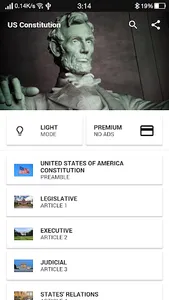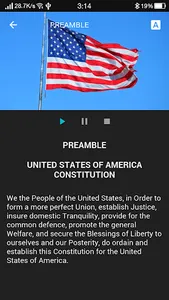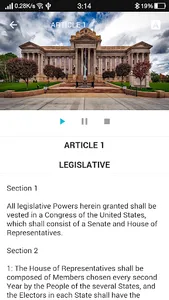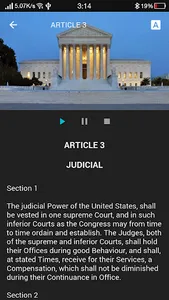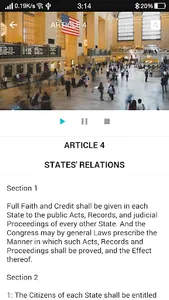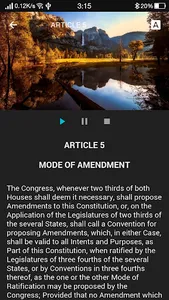The complete and handy ebook on the United States Constitution.
With FREE audiobook
With search function to enable readers to select their preferred topic.
For aspiring US citizens, teachers, students, policy makers or just anyone interested in the supreme law of the USA.
The US Constitution establishes the national government, the fundamental laws of the land, and rights of US citizens. It is composed of seven articles. The first three articles explain the separation of powers in the government, where the federal government is divided into the executive, legislative, and the judiciary. The law sets a system of check and balances to ensure balance of power. Articles 4, 5, and 6 show the concept of federalism, where the rights and responsibilities of state governments and the relationship of the states with the federal government are stated. Article 7 cites the procedures used by the states to ratify it.
The US Constitution was ratified by delegates to the Constitutional Convention in Philadelphia on September 17, 1787. The US Constitution was amended 27 times to cater to the changing needs of the nation. The Bill of Rights was added to guarantee individual freedom and protection, such as freedom of speech and religion. Other amendments broaden civil rights protection and changed government processes.
The US Constitution is considered "the oldest written and codified constitution of the world".
HISTORICAL TIMELINE:
1775 - Revolutionary War begins (the 13 Colonies revolt against the British)
1776 - Declaration of Independence written and approved by the Continental Congress
1781 - Revolutionary War ends. The Continental Congress agrees on the Articles of Confederation. The Continental Congress is replaced by the Congress of the Confederation, which forms the basis of the new US government.
1783 - Britain recognizes the independence of the USA (Treaty of Paris)
1787 - US Constitution written at the Constitutional Convention in Philadelphia, PA
1788 - US Constitution ratified by 9 states and becomes the supreme law of the USA
1789 - George Washington elected first President of the USA. The first Congress met in New York.
1790 - First Supreme Court assembled in NY. The Chief Justice was John Jay. US capital moves to Philadelphia
1791 - The Bill of Rights was added to the Constitution.
1800 = US capital moves to Washington, District of Columbia
1802 - Marbury v. Madison - the first time that the court found that a law was unconstitutional (John Marshall was Chief Justice)
1861 - Abraham Lincoln elected President. The Civil War begins
1865 - Civil War ends.
Amendment 13 - Slavery abolished
Abraham Lincoln assassinated.
1868 - Amendment 14 - Rights of citizenship to all people born in USA or naturalized
1870 - Amendment 15 - Gives the right to vote to all citizens, regardless of color or race, but women are not mentioned
1913 - Amendment 16 - Income tax begins
1920 - Amendment 19 - Women's suffrage (women given the right to vote)
1971 - Amendment 26 - Voting age lowered to 18
1992 - Amendment 27 - Congressional pay increases go into effect only during the next Congressional session
Source: Enchanted Learning
With FREE audiobook
With search function to enable readers to select their preferred topic.
For aspiring US citizens, teachers, students, policy makers or just anyone interested in the supreme law of the USA.
The US Constitution establishes the national government, the fundamental laws of the land, and rights of US citizens. It is composed of seven articles. The first three articles explain the separation of powers in the government, where the federal government is divided into the executive, legislative, and the judiciary. The law sets a system of check and balances to ensure balance of power. Articles 4, 5, and 6 show the concept of federalism, where the rights and responsibilities of state governments and the relationship of the states with the federal government are stated. Article 7 cites the procedures used by the states to ratify it.
The US Constitution was ratified by delegates to the Constitutional Convention in Philadelphia on September 17, 1787. The US Constitution was amended 27 times to cater to the changing needs of the nation. The Bill of Rights was added to guarantee individual freedom and protection, such as freedom of speech and religion. Other amendments broaden civil rights protection and changed government processes.
The US Constitution is considered "the oldest written and codified constitution of the world".
HISTORICAL TIMELINE:
1775 - Revolutionary War begins (the 13 Colonies revolt against the British)
1776 - Declaration of Independence written and approved by the Continental Congress
1781 - Revolutionary War ends. The Continental Congress agrees on the Articles of Confederation. The Continental Congress is replaced by the Congress of the Confederation, which forms the basis of the new US government.
1783 - Britain recognizes the independence of the USA (Treaty of Paris)
1787 - US Constitution written at the Constitutional Convention in Philadelphia, PA
1788 - US Constitution ratified by 9 states and becomes the supreme law of the USA
1789 - George Washington elected first President of the USA. The first Congress met in New York.
1790 - First Supreme Court assembled in NY. The Chief Justice was John Jay. US capital moves to Philadelphia
1791 - The Bill of Rights was added to the Constitution.
1800 = US capital moves to Washington, District of Columbia
1802 - Marbury v. Madison - the first time that the court found that a law was unconstitutional (John Marshall was Chief Justice)
1861 - Abraham Lincoln elected President. The Civil War begins
1865 - Civil War ends.
Amendment 13 - Slavery abolished
Abraham Lincoln assassinated.
1868 - Amendment 14 - Rights of citizenship to all people born in USA or naturalized
1870 - Amendment 15 - Gives the right to vote to all citizens, regardless of color or race, but women are not mentioned
1913 - Amendment 16 - Income tax begins
1920 - Amendment 19 - Women's suffrage (women given the right to vote)
1971 - Amendment 26 - Voting age lowered to 18
1992 - Amendment 27 - Congressional pay increases go into effect only during the next Congressional session
Source: Enchanted Learning
Show More
